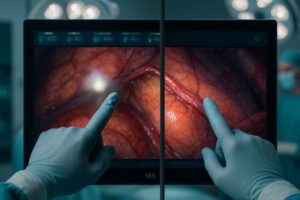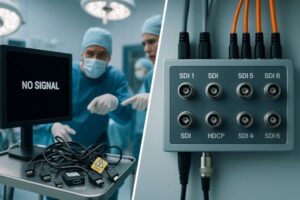Unstable power is a hidden threat in many hospital environments. This electrical instability can silently cripple critical medical displays. Understanding this risk is crucial to protect vital equipment and ensure uninterrupted patient care.
Yes, power fluctuations such as voltage surges, sags, and spikes can indeed damage sensitive internal components of medical displays. These events can degrade performance over time or cause complete failure if the display lacks adequate internal protection mechanisms.
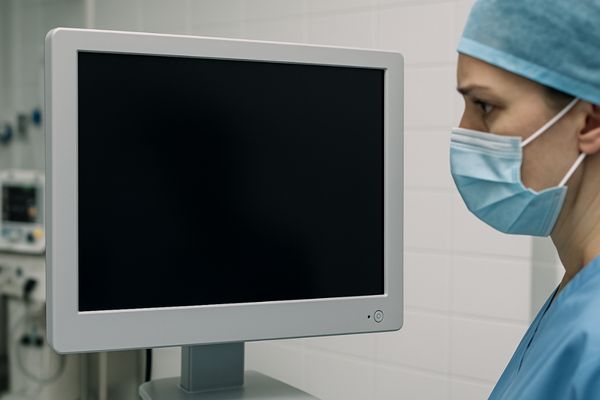
The reliability of electrical power can significantly impact medical equipment. This article will explore the types of power fluctuations1 that can affect displays. We will also identify vulnerable components, discuss protective measures2, outline clinical consequences of failures3, and explain how we enhance power stability in our systems.
What kinds of power fluctuations can affect medical displays?
Hospital power grids, especially in older buildings, can be surprisingly unstable. This instability poses a constant, often unseen, threat to sensitive medical devices. We will now explore the common power problems that can affect your displays.
Medical displays can be affected by several types of power fluctuations. These include voltage sags (dips), surges (swells), spikes (brief, intense over-voltages), and blackouts (complete power loss). These events often occur in older facilities or when high-power equipment cycles on or off.
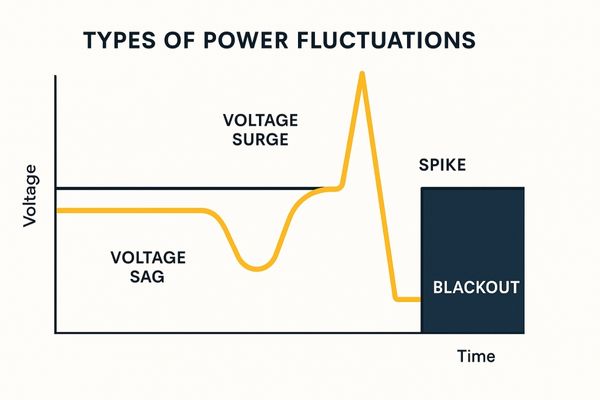
Power quality issues are a common concern in healthcare facilities.
Voltage Sags
Voltage sags4, or brownouts, are temporary decreases in voltage levels. They can occur when large equipment, like an MRI machine, starts up and draws significant current. Sags can cause displays to flicker, reset, or shut down unexpectedly. This can interrupt critical tasks.
Voltage Surges
Voltage surges5, or swells, are temporary increases in voltage. These can happen when heavy electrical loads are turned off, or due to utility grid switching. Surges stress electronic components, potentially leading to overheating and premature failure.
Voltage Spikes
Voltage spikes are very short but very high-energy bursts of voltage. Lightning strikes or the switching of inductive loads can cause them. Spikes can inflict immediate and severe damage to sensitive microelectronics within a display.
Blackouts6
Blackouts are a complete loss of power. While Uninterruptible Power Supplies (UPS) can mitigate this for critical systems, the sudden loss and restoration of power can still stress display components if not managed correctly. Without proper protection, these fluctuations can severely disrupt display operation and longevity.
Which internal components are most vulnerable to voltage instability?
Power issues might seem invisible, yet they can strike vital parts within a display. Your display’s core components are silently at risk from this electrical instability. We will now identify the internal parts that are most susceptible to damage.
The power supply unit (PSU), the mainboard (motherboard), the LCD driver board, and the image processor are the internal components most vulnerable to voltage instability. These parts manage power distribution and critical signal processing, making them highly susceptible to damage from anomalies.
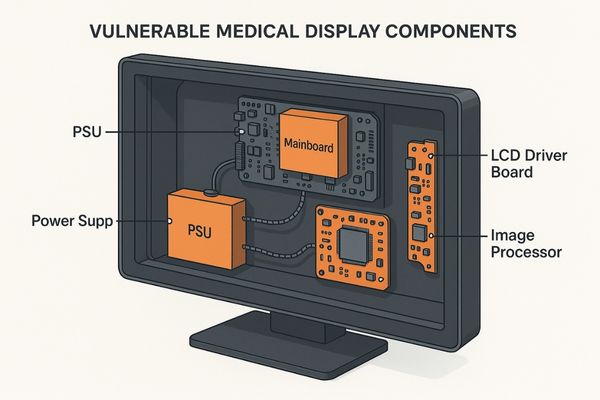
Several key components within a medical display are particularly sensitive to power irregularities.
The Power Supply Unit (PSU)7 is the first component to receive incoming electricity. It converts AC power from the wall outlet to the various DC voltages needed by the display’s internal circuits. While it offers some level of protection, severe fluctuations can overwhelm it, leading to its failure or allowing damaging voltages to pass through.
The Mainboard8 houses the central processing unit, memory, and control logic. These intricate circuits operate on precise, stable voltages. Fluctuations can corrupt data, cause erratic behavior, or permanently damage these sensitive integrated circuits.
The LCD Driver Board9 controls the individual pixels on the screen. It requires stable power to accurately manage the voltage applied to each pixel. Unstable power can lead to image artifacts like lines, flickering, incorrect colors, or even areas of dead pixels.
The Image Processor is responsible for complex video signal processing and image enhancement. These high-performance chips are also very sensitive to power quality. Fluctuations can cause processing errors, visible as image distortions, or can lead to the failure of the processor itself. Repeated exposure to even minor instability can degrade these components over time.
| Component | Primary Function | Susceptibility to Power Fluctuations |
|---|---|---|
| Power Supply Unit | Converts and regulates input power | High (first point of contact, can be overwhelmed) |
| Mainboard | Controls overall display operation | High (sensitive microprocessors and memory) |
| LCD Driver Board | Manages pixel activation and timing | Moderate to High (can cause visual artifacts) |
| Image Processor | Processes and enhances video signals | High (complex ICs requiring stable power) |
This table highlights the critical roles and vulnerabilities of key internal components.
How do medical-grade displays protect themselves from power surges?
Power surges, spikes, and other electrical disturbances are a constant threat to your valuable equipment. Without proper safeguards, displays can suffer costly damage and disruptive downtime. Learn how medical displays are designed to defend against these electrical attacks.
Medical-grade displays typically incorporate several layers of built-in protection. These include over-voltage protection (OVP) and under-voltage protection (UVP) circuits, surge absorbers like Metal Oxide Varistors (MOVs), and Electromagnetic Interference (EMI) filters to shield sensitive internal electronics.
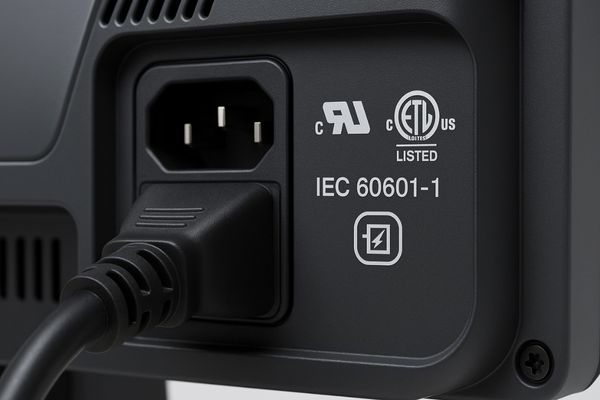
To ensure reliability in demanding medical environments, displays designed for clinical use integrate robust power protection. This is often a multi-layered approach. Over-Voltage Protection (OVP)10 circuits monitor the incoming voltage and will shut down the display or clamp the voltage if it exceeds a predefined safe upper limit. This protects against sustained surges or swells. Conversely, Under-Voltage Protection (UVP)11 safeguards against sags or brownouts by shutting the display off if the voltage drops too low, preventing erratic operation or damage from insufficient power.
Surge Absorbers12, such as Metal Oxide Varistors (MOVs) or Transient Voltage Suppressor (TVS) diodes, are critical. These components are designed to detect and divert the excess energy from very short, high-voltage spikes away from sensitive downstream circuits, often shunting it to ground. EMI/RFI (Electromagnetic/Radio Frequency Interference) filters also play a role by cleaning up high-frequency noise on the power line, which can disrupt electronic performance. These protective elements are usually integrated into the display’s internal power supply unit, forming a crucial defense against common power line disturbances.
What are the clinical consequences of power-related component failures?
A sudden display failure in a clinical setting can have immediate and serious consequences. Patient care, diagnostic accuracy, and procedural efficiency can be directly impacted by such power-related damage. We will explore the critical clinical impacts of these failures.
Power-related component failures in medical displays can lead to interrupted surgical procedures, delayed critical diagnoses, compromised patient safety due to loss of visual information, and potential loss of unsaved data. This is especially problematic during image-guided interventions or urgent diagnostic reviews.
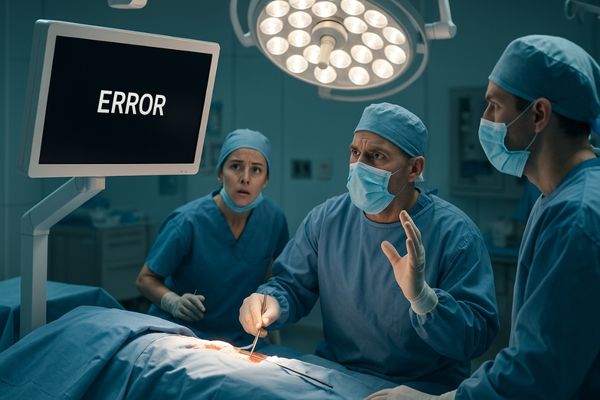
The failure of a medical display13 due to power issues can have significant ripple effects throughout a clinical workflow. During an image-guided surgery14, such as endoscopy or interventional radiology, a sudden screen blackout means the surgeon loses vital visual guidance. This can halt the procedure, necessitate a switch to backup equipment (if available), increase procedure time, and potentially elevate risks for the patient.
In diagnostic settings15, like a radiologist reviewing urgent scans, a display failure prevents image viewing. This directly delays diagnosis and subsequent treatment decisions. If the display malfunctions by showing distorted or inaccurate images before failing completely, there’s even a risk of misinterpretation. For multi-modality comparisons, where physicians compare images from different scans (e.g., PET and CT), the failure of one display in a paired setup can render the comparison ineffective. Beyond immediate procedural or diagnostic impacts, such failures lead to rescheduled appointments, increased operational stress for staff, and costs associated with repair or replacement.
How does Reshin enhance power stability in its medical display systems?
Choosing a medical display involves trusting its internal resilience against common environmental challenges like power inconsistencies. Not all displays are built with the same level of robustness to withstand these issues. Discover how we engineer our displays for superior power stability.
We enhance power stability in our medical display systems by using robust medical-grade power supplies, designing for wide input voltage tolerance, and incorporating active thermal management. These features work together to ensure consistent performance and protect internal components, even under unstable power conditions.
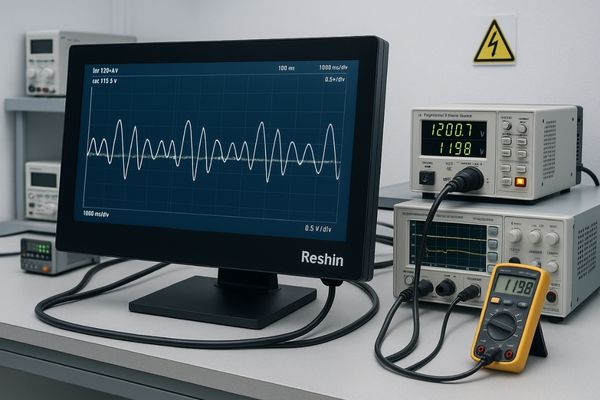
We prioritize operational reliability in our medical display designs. This includes specific measures to counteract power instability. Firstly, we utilize medical-grade power supplies16. These are built with higher quality components and more stringent manufacturing standards than typical consumer-grade PSUs. They inherently include more robust OVP, UVP, and surge suppression circuits, and comply with medical safety standards like IEC 60601-1, which includes requirements for power input integrity.
Secondly, our displays are engineered with a wide voltage tolerance17. This means they can operate reliably across a broader range of input AC voltages without performance degradation or shutdown. This makes them less susceptible to minor sags and swells common in some facilities. Thirdly, we implement active thermal management18. Power fluctuations can cause components, especially within the PSU, to generate excess heat. Efficient cooling, through careful component layout, heat sinks, and sometimes intelligent fan control, prevents overheating. Overheating can exacerbate the effects of power instability and shorten component lifespan. These combined strategies ensure our displays deliver consistent performance and longevity.
| Feature | Description | Benefit in Unstable Power Environments |
|---|---|---|
| Medical-Grade PSU | Higher quality components, enhanced protection circuits, IEC 60601-1 compliant | Greater resilience to surges, sags, and noise |
| Wide Voltage Tolerance | Designed to operate reliably over a broader input voltage range (e.g., 100-240V AC) | Maintains operation during minor fluctuations |
| Active Thermal Management | Efficient cooling to prevent internal components from overheating | Reduces stress on components, improves stability |
This table summarizes how our design choices contribute to enhanced power stability.
Conclusion
Power fluctuations pose a tangible risk to medical displays. They can damage vital internal components. However, well-designed medical-grade displays incorporate robust protective measures to ensure reliability and continuous clinical operation. To safeguard your workflows with power-protected medical monitors, contact Reshin at martin@reshinmonitors.com.
- Understanding power fluctuations is crucial for ensuring the reliability of medical equipment. Explore this link to learn more about their impact. ↩
- Discover essential protective measures that can help maintain the integrity of medical devices against power disturbances. ↩
- Learn about the serious clinical implications of power failures on medical equipment and patient safety by exploring this resource. ↩
- Understanding voltage sags is crucial for preventing disruptions in critical tasks. Explore this resource for in-depth insights. ↩
- Voltage surges can lead to overheating and failure of electronics. Learn more to protect your devices effectively. ↩
- Blackouts can severely disrupt operations. Discover strategies to mitigate their effects on your systems. ↩
- Understanding the PSU’s function is crucial for ensuring the reliability of medical displays, as it directly impacts performance and safety. ↩
- The Mainboard is vital for processing and control; learning more can help in troubleshooting and optimizing display performance. ↩
- Exploring issues related to the LCD Driver Board can help in maintaining display quality and preventing image artifacts. ↩
- Understanding OVP is essential for ensuring the safety and reliability of medical displays in clinical settings. Explore this link for detailed insights. ↩
- Learn about UVP’s critical role in preventing damage from low voltage situations, especially in sensitive medical equipment. This resource is invaluable. ↩
- Discover how surge absorbers safeguard electronics from voltage spikes, ensuring longevity and reliability in medical displays. A must-read for tech enthusiasts. ↩
- Understanding the implications of medical display failures can help improve patient safety and operational efficiency in healthcare settings. ↩
- Exploring the technology behind image-guided surgery can highlight its importance and the risks associated with display failures. ↩
- Learning about the consequences of display failures in diagnostics can inform better practices and technology investments in healthcare. ↩
- Explore how medical-grade power supplies enhance reliability and safety in medical devices, ensuring optimal performance. ↩
- Learn about the advantages of wide voltage tolerance in maintaining device performance during power fluctuations. ↩
- Discover the significance of active thermal management in preventing overheating and ensuring device longevity. ↩


